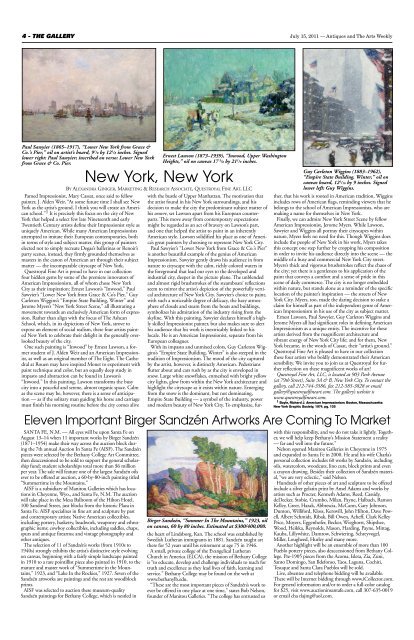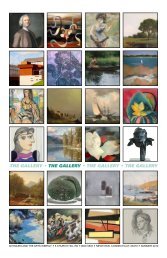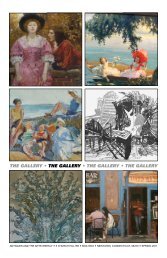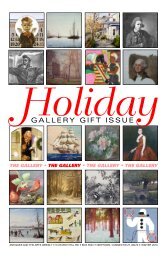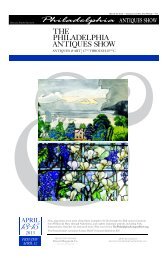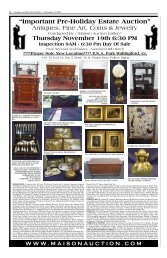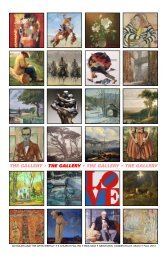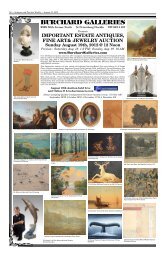Detail of “Mystic Seaport” by Carl Evers - Antiques and the Arts Online
Detail of “Mystic Seaport” by Carl Evers - Antiques and the Arts Online
Detail of “Mystic Seaport” by Carl Evers - Antiques and the Arts Online
You also want an ePaper? Increase the reach of your titles
YUMPU automatically turns print PDFs into web optimized ePapers that Google loves.
4 - THE GALLERY July 15, 2011 — <strong>Antiques</strong> <strong>and</strong> The <strong>Arts</strong> Weekly<br />
Paul Sawyier (1865–1917), “Lower New York from Grace &<br />
Co.’s Pier,” oil on artist’s board, 9 1 /8 <strong>by</strong> 12 1 /8 inches. Signed<br />
lower right: Paul Sawyier; inscribed on verso: Lower New York<br />
from Grace & Co. Pier.<br />
Famed Impressionist, Mary Cassat, once said to fellow<br />
painter, J. Alden Weir, “At some future time I shall see New<br />
York as <strong>the</strong> artist’s ground. I think you will create an American<br />
school.” 1 It is precisely this focus on <strong>the</strong> city <strong>of</strong> New<br />
York that helped a select few late Nineteenth <strong>and</strong> early<br />
Twentieth Century artists define <strong>the</strong>ir Impressionist style as<br />
uniquely American. While many American Impressionists<br />
attempted to imitate <strong>the</strong>ir European contemporaries, both<br />
in terms <strong>of</strong> style <strong>and</strong> subject matter, this group <strong>of</strong> painters<br />
elected not to simply recreate Degas’s ballerinas or Renoir’s<br />
party scenes, instead, <strong>the</strong>y firmly grounded <strong>the</strong>mselves as<br />
masters in <strong>the</strong> canon <strong>of</strong> American art through <strong>the</strong>ir subject<br />
matter — <strong>the</strong> incomparable cityscape <strong>of</strong> New York.<br />
Questroyal Fine Art is proud to have in our collection<br />
four hidden gems <strong>by</strong> some <strong>of</strong> <strong>the</strong> premiere innovators <strong>of</strong><br />
American Impressionism, all <strong>of</strong> whom chose New York<br />
City as <strong>the</strong>ir inspiration: Ernest Lawson’s “Inwood,” Paul<br />
Sawyier’s “Lower New York from Grace & Co’s Pier,” Guy<br />
<strong>Carl</strong>eton Wiggins’s “Empire State Building, Winter” <strong>and</strong><br />
Jerome Myers’s “New York Street Scene,” all illustrating a<br />
movement towards an exclusively American form <strong>of</strong> expression.<br />
Ra<strong>the</strong>r than align with <strong>the</strong> focus <strong>of</strong> The Ashcan<br />
School, which, in its depictions <strong>of</strong> New York, strove to<br />
expose an element <strong>of</strong> social realism, <strong>the</strong>se four artists painted<br />
New York to celebrate <strong>the</strong>ir delight in <strong>the</strong> generally overlooked<br />
beauty <strong>of</strong> <strong>the</strong> city.<br />
One such painting is “Inwood” <strong>by</strong> Ernest Lawson, a former<br />
student <strong>of</strong> J. Alden Weir <strong>and</strong> an American Impressionist,<br />
as well as an original member <strong>of</strong> The Eight. The Ca<strong>the</strong>dral<br />
at Rouen may have inspired Monet to experiment with<br />
paint technique <strong>and</strong> color, but an equally deep study in<br />
impasto <strong>and</strong> abstraction can be found in Lawson’s<br />
“Inwood.” In this painting, Lawson transforms <strong>the</strong> busy<br />
city into a peaceful <strong>and</strong> serene, almost organic space. Calm<br />
as <strong>the</strong> scene may be, however, <strong>the</strong>re is a sense <strong>of</strong> anticipation<br />
— as if <strong>the</strong> solitary man guiding his horse <strong>and</strong> carriage<br />
must finish his morning routine before <strong>the</strong> city comes alive<br />
Ernest Lawson (1873–1939), “Inwood, Upper Washington<br />
Heights,” oil on canvas 17 5 /8 <strong>by</strong> 21 1 /8 inches.<br />
New York, New York<br />
BY ALEXANDRA GINIGER, MARKETING & RESEARCH ASSOCIATE, QUESTROYAL FINE ART, LLC<br />
SANTA FE, N.M. — All eyes will be upon Santa Fe on<br />
August 13–14 when 11 important works <strong>by</strong> Birger S<strong>and</strong>zén<br />
(1871–1954) make <strong>the</strong>ir way across <strong>the</strong> auction block during<br />
<strong>the</strong> 7th annual Auction In Santa Fe (AISF). The S<strong>and</strong>zén<br />
pieces were selected <strong>by</strong> <strong>the</strong> Bethany College Art Committee,<br />
<strong>the</strong>n deaccessioned to be sold to support <strong>the</strong> general scholarship<br />
fund; student scholarships total more than $6 million<br />
per year. The sale will feature one <strong>of</strong> <strong>the</strong> largest S<strong>and</strong>zén oils<br />
ever to be <strong>of</strong>fered at auction, a 60-<strong>by</strong>-80-inch painting titled<br />
“Summertime in <strong>the</strong> Mountains.”<br />
AISF is a subsidiary <strong>of</strong> Manitou Galleries which has locations<br />
in Cheyenne, Wyo., <strong>and</strong> Santa Fe, N.M. The auction<br />
will take place in <strong>the</strong> Mesa Ballroom <strong>of</strong> <strong>the</strong> Hilton Hotel,<br />
100 S<strong>and</strong>oval Street, just blocks from <strong>the</strong> historic Plaza in<br />
Santa Fe. AISF specializes in fine art <strong>and</strong> sculpture <strong>by</strong> past<br />
<strong>and</strong> contemporary artists; Native American collectibles,<br />
including pottery, basketry, beadwork, weaponry <strong>and</strong> ethnographic<br />
items; cowboy collectibles, including saddles, chaps,<br />
spurs <strong>and</strong> antique firearms; <strong>and</strong> vintage photography <strong>and</strong><br />
o<strong>the</strong>r antiques.<br />
The selection <strong>of</strong> 11 <strong>of</strong> S<strong>and</strong>zén’s works (from 1910s to<br />
1940s) strongly exhibits <strong>the</strong> artist’s distinctive style evolving<br />
on canvas, beginning with a fairly simple l<strong>and</strong>scape painted<br />
in 1910 to a rare pointillist piece also painted in 1910, to <strong>the</strong><br />
mature <strong>and</strong> master work <strong>of</strong> “Summertime in <strong>the</strong> Mountains,”<br />
1923, <strong>and</strong> “Lake In <strong>the</strong> Rockies,” 1927. Seven <strong>of</strong> <strong>the</strong><br />
S<strong>and</strong>zén artworks are paintings <strong>and</strong> <strong>the</strong> rest are woodblock<br />
prints.<br />
AISF was selected to auction <strong>the</strong>se museum-quality<br />
S<strong>and</strong>zén paintings for Bethany College, which is nestled in<br />
with <strong>the</strong> bustle <strong>of</strong> Upper Manhattan. The motivation that<br />
<strong>the</strong> artist found in his New York surroundings, <strong>and</strong> his<br />
decision to make <strong>the</strong> city <strong>the</strong> predominant subject matter <strong>of</strong><br />
his oeuvre, set Lawson apart from his European counterparts.<br />
This move away from contemporary expectations<br />
might be regarded as an act <strong>of</strong> bravery on Lawson’s part,<br />
<strong>and</strong> one that helped <strong>the</strong> artist to paint in an inherently<br />
American style. Lawson solidified his place as one <strong>of</strong> America’s<br />
great painters <strong>by</strong> choosing to represent New York City.<br />
Paul Sawyier’s “Lower New York from Grace & Co.’s Pier”<br />
is ano<strong>the</strong>r beautiful example <strong>of</strong> <strong>the</strong> genius <strong>of</strong> American<br />
Impressionism. Sawyier gently draws his audience in from<br />
nature to cityscape with <strong>the</strong> calm, richly colored waters in<br />
<strong>the</strong> foreground that lead our eyes to <strong>the</strong> developed <strong>and</strong><br />
industrial city, deeper in <strong>the</strong> picture plane. The unblended<br />
<strong>and</strong> almost rigid brushstrokes <strong>of</strong> <strong>the</strong> steamboats’ reflections<br />
seem to mirror <strong>the</strong> artist’s depiction <strong>of</strong> <strong>the</strong> powerfully vertical<br />
architecture <strong>of</strong> New York City. Sawyier’s choice to paint,<br />
with such a noticeable degree <strong>of</strong> delicacy, <strong>the</strong> hazy atmosphere<br />
<strong>of</strong> clouds <strong>and</strong> steam from <strong>the</strong> boats <strong>and</strong> buildings,<br />
symbolizes his admiration <strong>of</strong> <strong>the</strong> industry rising from <strong>the</strong><br />
skyline. With this painting, Sawyier declares himself a highly<br />
skilled Impressionist painter, but also makes sure to alert<br />
his audience that his work is inextricably linked to his<br />
locale. He is an American Impressionist, separate from his<br />
European colleagues.<br />
With its impasto <strong>and</strong> unmixed colors, Guy <strong>Carl</strong>eton Wiggins’s<br />
“Empire State Building, Winter” is also steeped in <strong>the</strong><br />
tradition <strong>of</strong> Impressionism. The mood <strong>of</strong> <strong>the</strong> city captured<br />
<strong>by</strong> <strong>the</strong> artist, however, is distinctly American. Pedestrians<br />
flutter about <strong>and</strong> cars rush <strong>by</strong> as <strong>the</strong> city is enveloped in<br />
snow. Large white snowflakes, enmeshed with bright yellow<br />
city lights, glow from within <strong>the</strong> New York architecture <strong>and</strong><br />
highlight <strong>the</strong> cityscape as it exists within nature. Emerging<br />
from <strong>the</strong> snow is <strong>the</strong> dominant, but not dominating,<br />
Empire State Building — a symbol <strong>of</strong> <strong>the</strong> industry, power<br />
<strong>and</strong> modern beauty <strong>of</strong> New York City. To emphasize, fur-<br />
Birger S<strong>and</strong>zén, “Summer In The Mountains,” 1923, oil<br />
on canvas, 60 <strong>by</strong> 80 inches. Estimated at $300/400,000.<br />
<strong>the</strong> heart <strong>of</strong> Lindsborg, Kan. The school was established <strong>by</strong><br />
Swedish Lu<strong>the</strong>ran immigrants in 1881. S<strong>and</strong>zén taught art<br />
<strong>the</strong>re for 52 years until his retirement at age 75 in 1946.<br />
A small, private college <strong>of</strong> <strong>the</strong> Evangelical Lu<strong>the</strong>ran<br />
Church in America (ELCA), <strong>the</strong> mission <strong>of</strong> Bethany College<br />
is “to educate, develop <strong>and</strong> challenge individuals to reach for<br />
truth <strong>and</strong> excellence as <strong>the</strong>y lead lives <strong>of</strong> faith, learning <strong>and</strong><br />
service.” Bethany College may be found on <strong>the</strong> web at<br />
www.bethanylb.edu.<br />
“These are <strong>the</strong> most important pieces <strong>of</strong> S<strong>and</strong>zén’s work to<br />
ever be <strong>of</strong>fered in one place at one time,” states Bob Nelson,<br />
founder <strong>of</strong> Manitou Galleries. “The college has entrusted us<br />
Guy <strong>Carl</strong>eton Wiggins (1883–1962),<br />
“Empire State Building, Winter,” oil on<br />
canvas board, 12 1 /16 <strong>by</strong> 9 inches. Signed<br />
lower left: Guy Wiggins.<br />
<strong>the</strong>r, that his work is rooted in American tradition, Wiggins<br />
includes rows <strong>of</strong> American flags, reminding viewers that he<br />
belongs to <strong>the</strong> school <strong>of</strong> American Impressionists, who are<br />
making a name for <strong>the</strong>mselves in New York.<br />
Finally, we can admire New York Street Scene <strong>by</strong> fellow<br />
American Impressionist, Jerome Myers. While Lawson,<br />
Sawyier <strong>and</strong> Wiggins all portray <strong>the</strong>ir cityscapes within<br />
nature, Myers feels no need for this. Though Wiggins does<br />
include <strong>the</strong> people <strong>of</strong> New York in his work, Myers takes<br />
this concept one step fur<strong>the</strong>r <strong>by</strong> cropping his composition<br />
in order to invite his audience directly into <strong>the</strong> scene — <strong>the</strong><br />
middle <strong>of</strong> a busy <strong>and</strong> commercial New York City street.<br />
Myers’s thick <strong>and</strong> vigorous brushstrokes reflect <strong>the</strong> chaos <strong>of</strong><br />
<strong>the</strong> city; yet <strong>the</strong>re is a gentleness to his application <strong>of</strong> <strong>the</strong><br />
paint that conveys a comfort <strong>and</strong> a sense <strong>of</strong> pride in this<br />
scene <strong>of</strong> daily commerce. The city is no longer embedded<br />
within nature, but st<strong>and</strong>s alone as a reminder <strong>of</strong> <strong>the</strong> specific<br />
location <strong>of</strong> <strong>the</strong> painter’s inspiration — <strong>the</strong> streets <strong>of</strong> New<br />
York City. Myers, too, made <strong>the</strong> daring decision to stake a<br />
claim for himself as part <strong>of</strong> <strong>the</strong> independent genre <strong>of</strong> American<br />
Impressionism in his use <strong>of</strong> <strong>the</strong> city as subject matter.<br />
Ernest Lawson, Paul Sawyier, Guy <strong>Carl</strong>eton Wiggins <strong>and</strong><br />
Jerome Myers all had significant roles in defining American<br />
Impressionism as a unique entity. The incentive for <strong>the</strong>se<br />
artists derived from <strong>the</strong> magnificent architecture <strong>and</strong><br />
vibrant energy <strong>of</strong> New York City life; <strong>and</strong> for <strong>the</strong>m, New<br />
York became, in <strong>the</strong> words <strong>of</strong> Cassat, <strong>the</strong>ir “artist’s ground.”<br />
Questroyal Fine Art is pleased to have in our collection<br />
<strong>the</strong>se four artists who boldly demonstrated <strong>the</strong>ir American<br />
sensibility. We invite you to join us at Questroyal for fur<strong>the</strong>r<br />
reflection on <strong>the</strong>se magnificent works <strong>of</strong> art!<br />
Questroyal Fine Art, LLC, is located at 903 Park Avenue<br />
(at 79th Street), Suite 3A & B, New York City. To contact <strong>the</strong><br />
gallery, call 212-744-3586, fax 212-585-3828 or email<br />
gallery@questroyalfineart.com. The gallery’s website is<br />
www.questroyalfineart.com.<br />
1 Boyle, Richard J. American Impressionism. Boston, Massachusetts:<br />
New York Graphic Society, 1974. pg. 105<br />
Eleven Important Birger S<strong>and</strong>zén Artworks Are Coming To Market<br />
with this responsibility, <strong>and</strong> we do not take it lightly. Toge<strong>the</strong>r,<br />
we will help keep Bethany’s Mission Statement a reality<br />
— far <strong>and</strong> well into <strong>the</strong> future.”<br />
Nelson opened Manitou Galleries in Cheyenne in 1975<br />
<strong>and</strong> exp<strong>and</strong>ed to Santa Fe in 2000. He <strong>and</strong> his wife Charla’s<br />
personal collection includes 60 works <strong>by</strong> S<strong>and</strong>zén, including<br />
oils, watercolors, woodcuts, lino cuts, block prints <strong>and</strong> even<br />
a crayon drawing. Besides <strong>the</strong>ir collection <strong>of</strong> S<strong>and</strong>zén material,<br />
“we are very eclectic,” said Nelson.<br />
Hundreds <strong>of</strong> o<strong>the</strong>r pieces <strong>of</strong> art <strong>and</strong> sculpture to be <strong>of</strong>fered<br />
include a silver gelatin print <strong>by</strong> Ansel Adams <strong>and</strong> works <strong>by</strong><br />
artists such as Procter, Kenneth Adams, Reed, Cassidy,<br />
deDecker, Stobie, Crumbo, Milan, Payne, Halbach, Ramon<br />
Kelley, Greer, Hazak, Abbrescia, McCann, Gary Johnson,<br />
Dunton, Williford, Kloss, Kerswill, John Hilton, Dave Powell,<br />
Albert Schmidt, Ribak, Bill Owen, Acheff, Clark Kelley<br />
Price, Moyers, Eggenh<strong>of</strong>er, Becker, Wieghorst, Shipshee,<br />
Wood, Heikka, Reynolds, Mason, Harding, Payne, Mittag,<br />
Kauba, Lillywhite, Damrow, Schwiering, Schreyvogel,<br />
Miller, Lougheed, Hurley <strong>and</strong> many more.<br />
Ano<strong>the</strong>r highlight will be an ensemble <strong>of</strong> more than 100<br />
Pueblo pottery pieces, also deaccessioned from Bethany College.<br />
Pre-1905 pieces from <strong>the</strong> Acoma, Isleta, Zia, Zuni,<br />
Santo Domingo, San Ildefonso, Taos, Laguna, Cochiti,<br />
Tesuque <strong>and</strong> Santa Clara Pueblos will be sold.<br />
Live, absentee <strong>and</strong> telephone bidding will be available.<br />
There will be Internet bidding through www.iCollector.com.<br />
For general information <strong>and</strong>/or to order a full-color catalog<br />
for $25, visit www.auctioninsantafe.com, call 307-635-0019<br />
or email cha rlajmg@aol.com.


